by Anita Kamouri, P h. D. and Amanda Aviles — As more companies adopt flexible workplace strategies, there has been increased interest in their potential impacts on human capital outcomes. However, in contrast to projected cost savings due to changes in workspace utilization, the projected benefits of new workplace strategies on human capital outcomes are not as easily quantified. To support acceptance of flexible workplace strategies, the potential benefits of workplace design for employee engagement, performance and collaboration need to be made as salient to business decision makers as workplace cost considerations. This article describes an approach taken by Apollo Education Group’s Real Estate and Facilities (REF) team to create a balanced business case for implementing a flexible workplace strategy that includes both workplace and human capital metrics.
Apollo’s ‘MyWorkplace’ Program
Apollo Education Group, Inc. is one of the world’s largest private education providers and has been in the education business for approximately 40 years. In 2011, REF initiated consolidation of its Phoenix-based corporate portfolio in an effort to reduce vacancy rates and space costs. As part of this effort, internal research was conducted with about 12,000 Phoenix-based employees that suggested the need for the workplace to support greater flexibility, collaborative work practices and employee engagement. In response, REF developed a new flexible workplace program called ‘MyWorkplace’ as an integral part of an overall portfolio optimization plan by integrating industry best practices in workspace, technology, human resources and flexible/remote work practices. It was intended to meet both cost savings and business goals by enabling a more productive and engaging workplace experience for employees.
Creating a Balanced Business Case Approach
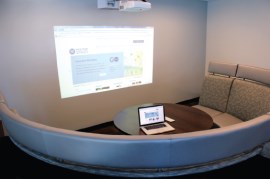
The first step in creating a compelling business case for the MyWorkplace program involved meeting with senior stakeholders from across the organization to identify their criteria for business success. While acknowledging the potential cost savings of flexible workplace strategies, the potential risk to employee productivity or collaboration was a key issue, since any decline in business performance could quickly outweigh the financial value of workspace cost reductions. The resulting Success Criteria clarified that both human capital metrics and workplace cost metrics need to be included in any evaluation of the flexible workspace strategy. Next, using a Balanced Scorecard framework as a foundation, a Balanced Business Case model was created that incorporated four measurement perspectives based on critical human capital and workplace Success Criteria: Effectiveness, Employee, Environmental and Efficiency.
Building the Business Case
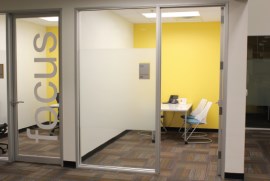
Although industry benchmarks and flexible workplace research data were available, discussions with business leaders indicated that a convincing business case needed to be Apollo-specific, data-based and cost effective (i.e., not require costly changes or investment in a pilot). REF faced the challenge of creating a data-based business case prior to implementing the program and without conducting a pilot.
After exploring the options, it was decided that the best way to build the business case would be to capitalize on naturally occurring flexible/remote work practices that already existed within the workforce. Fortunately, at the time the business case was being developed, Apollo had approximately 700 employees participating in a legacy telework program. REF believed that an evaluation of this group could provide an indication of the potential impact that might be expected from the MyWorkplace program while satisfying the goals of being Apollo-specific and data-based.
The next step involved quantifying and measuring the Success Criteria for the legacy telework participants as well as for a matched group of non-telework employees. A rigorous datagathering approach was used to isolate the impacts of participation from confounding factors, such as participant selection, and changes in economic conditions and business processes over time. To create the most meaningful business case, REF worked with each business unit to identify how they measure and track work productivity. This helped focus data gathering on the most valid and reliable, current and historical data.
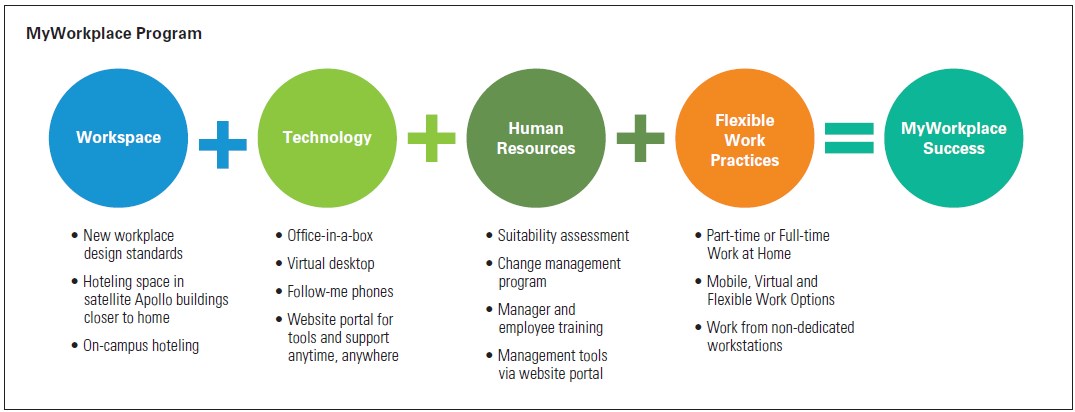
Quantifying Business Case Benefits
Once the data were collected, a systematic evaluation was undertaken to determine the impact of the legacy telework program in each of the four business case perspectives. Data analyses revealed that legacy telework participants were significantly more engaged, more satisfied, less likely to leave the company, and more productive than before telework. The same results were also found when comparing telework participants to the matching non-telework employees. In addition to the positive human capital impacts, cost savings from reduced real estate footprint and emissions reduction from commute mitigation also were found. Because these results were specific to the legacy telework program, they needed to be extrapolated to the MyWorkplace program. The potential impact of a MyWorkplace pilot implementation with 700 pilot participants was estimated (see table, top right) using both tangible and intangible data, and entered into a cost/benefit analysis:
1. Tangible Workplace Metrics. Estimated benefits associated with seat savings, cost savings and environmental impacts and the expected investments due to space changes, new technology and training/change management were extrapolated using the expected number of program participants. The estimated workspace savings attributable to MyWorkplace participation produced a positive ROI and under one-year payback relative to up-front investment costs.
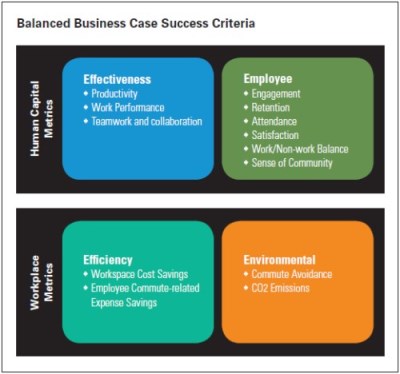
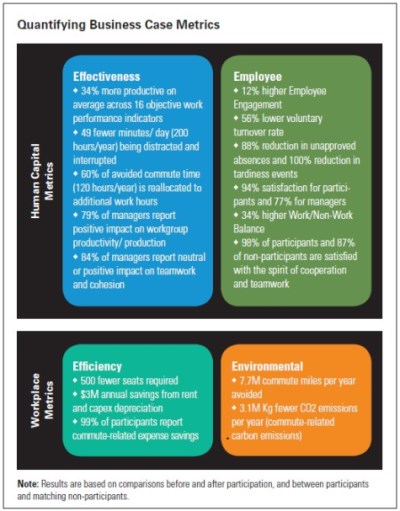
2. Tangible Human Capital Metrics. Several human capital metrics could be cost-valued using salary and replacement cost data, based on the number of expected MyWorkplace program participants. Financial estimates for these measures showed that flexible workplace strategy investments can be offset by not only workspace savings, but also by reduced voluntary turnover, lower absenteeism and greater productivity associated with participation.
3. Intangible Human Capital Metrics. Several human capital impacts, such as employee engagement, were not able to be directly valued in terms of dollars so they were not part of the cost/benefit analyses. However, they were still presented as critical components of the Balanced Business Case because they represented important Stakeholder Success Criteria, were drivers of other tangible metrics (for example, employee engagement as a predictor of productivity), and represented important organizational goals.
Building Organizational Support
The Balanced Business Case approach demonstrated that a strong argument for workplace flexibility can be created — one that emphasizes both real estate cost savings and the human capital benefit of flexible workplace strategies. Furthermore, being able to quantify and extrapolate business case metrics proved to be invaluable to REF in soliciting organizational support for the MyWorkplace program. Overall, the Balanced Business Case approach helped create momentum for the program and secure support for both the new workplace standards and work arrangement flexibility options.
The resulting MyWorkplace implementation captured the principle design goals of the MyWorkplace Program and included a mix of both private and collaborative workspaces.
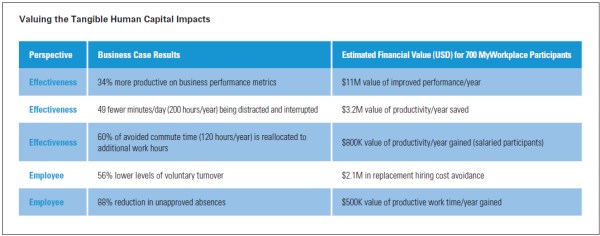
Driving Workplace Change
Creating a Balanced Business Case with an emphasis on human capital metrics encouraged REF to assume the role of a strategic partner that supports corporate real estate and business success. What were the major factors that supported this new role?
- Aligning CRE Goals with Business Goals
REF had to change its mindset and think beyond traditional workplace metrics and adopt new measures of business success. It became important to speak the same language as the business and to demonstrate that business goals drive REF decisions. - Taking Time to Build a Compelling Case
Rather than pushing forward to achieve only workspace goals, REF took the time to gather evidence and build a case that demonstrated the business efficacy of the solution. This proactive, measured approach increased leadership’s comfort level with the program. - Measuring Work Performance and Productivity
Having an operational definition of work performance or productivity is critical to effective implementation of flexible workplace strategies. If the business does not define performance when people are in the office, performance management of people working remotely and evaluation of the new program will be difficult. - Creating Cross-Functional Partnerships
Taking the time to collaborate with HR and IT partners on business case data collection was instrumental in gathering functional leadership support for MyWorkplace. The involvement of HR and IT partners in creating the Balanced Business Case helped secure investment commitments from functional leadership that were needed for the future success and scalability of the new workplace strategy. - Building Awareness Early and Often
Findings such as those reported in the MyWorkplace business case can challenge some of the perceived barriers to workforce flexibility. Data demonstrating the human capital benefits of new workplace strategies can be used to create “success stories” and support change management efforts within organizations who want to introduce or expand flexible workplace initiatives.
In summary, the Balanced Business Case approach was successful in generating the leadership support necessary for the MyWorkplace program’s adoption. It also introduced metrics that can be used over the lifecycle of the program creating the ability to directly evaluate whether the project is progressing as intended. As REF works toward improving its physical footprint to support business success, these new perspectives and approaches will continue help drive the long-term success of Apollo’s new workplace strategies.
About the Authors

Anita Kamouri, Ph.D., is Vice President and cofounder
at Iometrics, Inc. She has been working with
clients to design, implement and evaluate alternative
workplace strategies for over 15 years.

Amanda Aviles is Apollo’s Director of Real Estate
Strategy and Planning. Apollo Education Group is
one of the world’s largest private education providers.
Amanda is the Program Manager of the company’s
MyWorkplace Program.